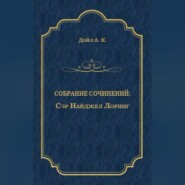По всем вопросам обращайтесь на: info@litportal.ru
(©) 2003-2024.
✖
The Return of Sherlock Holmes
Автор
Год написания книги
2019
Настройки чтения
Размер шрифта
Высота строк
Поля
The Return of Sherlock Holmes
Arthur Conan Doyle
HarperCollins is proud to present its incredible range of best-loved, essential classics.Originally published in 1903–1904, The Return of Sherlock Holmes is the thirteen-story collection of one of the greatest-ever fictional detectives. Three years after the supposed death of Sherlock Holmes and his archenemy Professor Moriarty in the torrent of Reichenbach Falls, Holmes makes a disguised reappearance to Baker Street and his good friend Dr Watson.Featuring one of Holmes’ greatest adversaries, Charles Augustus Milverton, as well as trademark astute logic, forensic science, murder, crytograms and magic, this collection retains all the hallmark brilliance of Arthur Conan Doyle’s best work.
THE RETURN OF SHERLOCK HOLMES
Arthur Conan Doyle
CONTENTS
Title Page (#ud2672011-0399-5004-b7e8-ddf2ed6f1906)
History of Collins
Life & Times (#u36ee2f45-8b00-5a79-a5cd-be422f3640fb)
Chapter 1: The Empty House
Chapter 2: The Norwood Builder
Chapter 3: The Dancing Men
Chapter 4: The Solitary Cyclist
Chapter 5: The Priory School
Chapter 6: Black Peter
Chapter 7: Charles Augustus Milverton
Chapter 8: The Six Napoleons
Chapter 9: The Three Students
Chapter 10: The Golden Pince-Nez
Chapter 11: The Missing Three-Quarter
Chapter 12: The Abbey Grange
Chapter 13: The Second Stain
Classic Literature: Words and Phrases adapted from the Collins English Dictionary (#litres_trial_promo)
Copyright (#litres_trial_promo)
About the Publisher (#litres_trial_promo)
History of Collins (#u2f27e504-2b77-5925-b6e4-9f1e8acd8161)
In 1819, millworker William Collins from Glasgow, Scotland, set up a company for printing and publishing pamphlets, sermons, hymn books and prayer books. That company was Collins and was to mark the birth of HarperCollins Publishers as we know it today. The long tradition of Collins dictionary publishing can be traced back to the first dictionary William published in 1824, Greek and English Lexicon. Indeed, from 1840 onwards, he began to produce illustrated dictionaries and even obtained a licence to print and publish the Bible.
Soon after, William published the first Collins novel, Ready Reckoner; however, it was the time of the Long Depression, where harvests were poor, prices were high, potato crops had failed and violence was erupting in Europe. As a result, many factories across the country were forced to close down and William chose to retire in 1846, partly due to the hardships he was facing.
Aged 30, William’s son, William II took over the business. A keen humanitarian with a warm heart and a generous spirit, William II was truly ‘Victorian’ in his outlook. He introduced new, up-to-date steam presses and published affordable editions of Shakespeare’s works and ThePilgrim’s Progress, making them available to the masses for the first time. A new demand for educational books meant that success came with the publication of travel books, scientific books, encyclopaedias and dictionaries. This demand to be educated led to the later publication of atlases and Collins also held the monopoly on scripture writing at the time.
In the 1860s Collins began to expand and diversify and the idea of ‘books for the millions’ was developed. Affordable editions of classical literature were published and in 1903 Collins introduced 10 titles in their Collins Handy Illustrated Pocket Novels. These proved so popular that a few years later this had increased to an output of 50 volumes, selling nearly half a million in their year of publication. In the same year, The Everyman’s Library was also instituted, with the idea of publishing an affordable library of the most important classical works, biographies, religious and philosophical treatments, plays, poems, travel and adventure. This series eclipsed all competition at the time and the introduction of paperback books in the 1950s helped to open that market and marked a high point in the industry.
HarperCollins is and has always been a champion of the classics and the current Collins Classics series follows in this tradition – publishing classical literature that is affordable and available to all. Beautifully packaged, highly collectible and intended to be reread and enjoyed at every opportunity.
Life & Times (#ulink_322533f7-3903-5aa2-8e72-7f069f14881a)
About the Author
Arthur Conan Doyle was born in Edinburgh, Scotland, in 1859, the year Charles Darwin’s The Origin of Species was published. Conan Doyle was raised Catholic but declared himself agnostic by the time he began reading medicine at Edinburgh University, in 1876. He attained his doctorate in 1885, researching a condition caused by syphilis, known as tabes dorsalis, and characterised by the degeneration of sensory neurons causing the body to malfunctions.
Conan Doyle’s professional life began with a stint as ship’s doctor on a voyage around the coast of west Africa. In early 1882, before his doctorate was complete, he set up a surgery in Plymouth, England, with a university friend. Unfortunately, their professional relationship was short-lived and Conan Doyle moved to Southsea, England, by that summer. He then established his own medical practice, but found that business was slow, so he worked on his writing, which he had enjoyed from an early age. By 1887, he had published his first Sherlock Holmes novel and steered his career in a different direction.
Between 1887 and 1927, Conan Doyle published nine Sherlock Holmes books: four novels and five collections of short stories. He wrote many other books, but Sherlock Holmes became such an iconic character that his other works were rather overshadowed. In fact, Conan Doyle made the decision to kill off Sherlock Holmes in 1894, in a short story entitled The Final Problem. There was such public outcry at the death of Sherlock Holmes that Conan Doyle was moved to bring him back to life in The Return of Sherlock Holmes.
Despite his agnosticism, Conan Doyle developed an interest in spiritualism, becoming fascinated by beliefs in supernatural phenomena, including the Cottingley Fairy photographs, now understood to be hoaxes. His obsession also created a rift between himself and his friend, escapologist Harry Houdini. Conan Doyle couldn’t accept that Houdini’s escapades were elaborate tricks and Houdini grew vexed at Conan Doyle’s insistence that he possessed magical powers.
Conan Doyle suffered from considerable personal tragedy in the early years of the 20th century. A number of family members died, including his wife Louise, in 1906, and his son Kingsley, in 1918. There was also the horror of World War I to contend with, which affected the entire nation’s morale.
The Influence of Science
One of Conan Doyle’s better-known other works is the science-fiction novel The Lost World, published in 1912. The character Professor Challenger mounts an expedition to the Amazon Basin. He and his entourage encounter all manner of prehistoric animals along the way and witness warfare between an indigenous tribe and ape-men. In context, this novel can be seen as a document of scientific inquiry at the time. The French science-fiction author Jules Verne had died six years before, leaving an anthology of similar stories, including Journey to the Centre of the Earth, 1864. Similarly, Conan Doyle’s contemporary, the English writer H. G. Wells, had published The Time Machine in 1895. These books all enabled the characters to visit other places in time and to witness extinct creatures brought back to life. This general theme proved popular in an era when fossils and the processes of evolution were beginning to be understood by science. Conan Doyle used science to underpin his literature, although it is fair to say that he allowed pseudoscience to also appear towards the end of his life. Sherlock Holmes was Conan Doyle’s expression of his recognition that the application of empirical science and acute intellect were the things that members of the British Empire saw as the reason for their success.
Sherlock Holmes
Arthur Conan Doyle originally invented and wrote about the character of Sherlock Holmes to fill his time during his period as a general practitioner. In 1887 came the first published appearance of Holmes, along with his faithful companion Dr Watson, in a novel entitled A Study in Scarlet. Then three years after that, in 1890, came his second, The Sign of Four.
These books established Conan Doyle as a successful author. The Adventures of Sherlock Holmes was published in 1892. Six of the twelve stories are described as ‘adventures’ in their title, because they were originally published singly in the Strand magazine and this provided a sense of continuity to the reader – a type of ‘product branding’. He had devised the detective mystery novel, considered a new genre at the time. Real-life crime cases were not usually very mysterious, but Conan Doyle recognised a need to elaborate for the sake of producing a good read. It is worth noting, however, that the case of the Whitehall Murders and Jack the Ripper had been prevalent in British newspapers in 1888, making the theme of mysterious crime-solving very topical. In fact, many of Conan Doyle’s fans wrote to him, suggesting that Sherlock Holmes attempt to solve the aforementioned crime. However, the author was wise enough to realise that there should be no crossover between fiction and fact, so Holmes was never called upon.
The private detective Sherlock Holmes was, in essence, a hybrid between the Victorian gentleman scientist and the police detective. The Victorian era marked an historical point where science came into its own as a distinct discipline based on empirical experimentation. Before then, science had been rather more ambiguous in its definition. Physicians, chemists and biologists had shown that the world always operates according to strict scientific rules and laws. It was this new phenomenon of scientific certainty that allowed Sherlock Holmes to confidently solve crimes in an age when police investigation was generally understood to be largely a matter of hit and miss, a mix of luck and judgement. Although a fictitious character, Holmes revolutionised the perception of what could be achieved by way of identifying and collecting evidence from crime scenes, theorising motives and courses of events and pinpointing suspects.
It suited the character development better for Holmes to be a private detective, as he evidently possessed a quality of intellectual genius which, so often, is accompanied by idiosyncrasies and eccentricities that make for a personality ill-suited to the routine and regulations of conventional employment.
To make Holmes believable as a character with an exceptional mind, he also needed to be flawed in certain ways, so the author made him something of a loner, with obsessive, fanatical and addictive traits. The result was a well-rounded character that the reader could understand, if not identify with, because he too had vulnerabilities and weaknesses common to us all. In fact, Conan Doyle openly admitted that the greatest part of Holmes was based on someone he knew: Professor Joseph Bell, a Scottish university lecturer and forensic pathologist. Conan Doyle had been impressed by the way Bell had implemented scientific analysis and detailed observation during post-mortem examinations in deducing the cause of death. Although commonplace now, a forensic approach was something quite new in 1877, when they first met.
Conan Doyle commented that Bell’s force of habit, or inculcation was one of observation, inference and deduction, so that the most likely cause of death was arrived at by a methodical process of elimination. It was a mindset of reason, logic and the application of acquired knowledge; perfect for a successful private investigator. The term Occam’s razor is sometimes applied to Holmes’ method, because it explains things by reducing, or razing, options so that assumptions and conclusions can be made with a reasonable level of accuracy and confidence.
At Sherlock Holmes’ side in all of his investigations is Dr John Watson, who acts as an enthusiastic deputy. He also narrates most of the Sherlock Holmes stories, so that the reader experiences events from a second-person perspective. Dr Watson is intelligent in his own right, but he admires Holmes for his ability to think about things on a higher plane. It is notable that Holmes has no letters before his name, because he is a free thinker and rejects the notion of establishment and official credentials.
Similarly, Holmes has a rather condescending view of those employed at Scotland Yard, the police headquarters in London. Inspector Lestrade is a Scotland Yard detective for whom Holmes has mixed feelings. On the one hand, he considers Lestrade the best detective on the force, but on the other hand, he seems to only tolerate him because Lestrade is useful and efficient at dealing with the more mundane duties of making arrests and providing manpower.
One notable characteristic of Sherlock Holmes is his penchant for dressing in disguise. Conan Doyle saw that it would be useful for Holmes to be a master of disguise, so that he could access situations without the requirement for assistants who might otherwise do the job for him. In effect, Holmes becomes another character while in disguise, thereby allowing him to glean vital information by stealth. In some ways, this was the forerunner to undercover police work, where detectives are expected to covertly gain the trust of criminals by pretending to be part of the gang or by observing from the sidelines. As a plot device, it was useful for Conan Doyle to have Holmes assume different disguises where necessary, to provide intelligence so that segue between elements of the investigation could be made.
The Return of Sherlock Holmes
Arthur Conan Doyle
HarperCollins is proud to present its incredible range of best-loved, essential classics.Originally published in 1903–1904, The Return of Sherlock Holmes is the thirteen-story collection of one of the greatest-ever fictional detectives. Three years after the supposed death of Sherlock Holmes and his archenemy Professor Moriarty in the torrent of Reichenbach Falls, Holmes makes a disguised reappearance to Baker Street and his good friend Dr Watson.Featuring one of Holmes’ greatest adversaries, Charles Augustus Milverton, as well as trademark astute logic, forensic science, murder, crytograms and magic, this collection retains all the hallmark brilliance of Arthur Conan Doyle’s best work.
THE RETURN OF SHERLOCK HOLMES
Arthur Conan Doyle
CONTENTS
Title Page (#ud2672011-0399-5004-b7e8-ddf2ed6f1906)
History of Collins
Life & Times (#u36ee2f45-8b00-5a79-a5cd-be422f3640fb)
Chapter 1: The Empty House
Chapter 2: The Norwood Builder
Chapter 3: The Dancing Men
Chapter 4: The Solitary Cyclist
Chapter 5: The Priory School
Chapter 6: Black Peter
Chapter 7: Charles Augustus Milverton
Chapter 8: The Six Napoleons
Chapter 9: The Three Students
Chapter 10: The Golden Pince-Nez
Chapter 11: The Missing Three-Quarter
Chapter 12: The Abbey Grange
Chapter 13: The Second Stain
Classic Literature: Words and Phrases adapted from the Collins English Dictionary (#litres_trial_promo)
Copyright (#litres_trial_promo)
About the Publisher (#litres_trial_promo)
History of Collins (#u2f27e504-2b77-5925-b6e4-9f1e8acd8161)
In 1819, millworker William Collins from Glasgow, Scotland, set up a company for printing and publishing pamphlets, sermons, hymn books and prayer books. That company was Collins and was to mark the birth of HarperCollins Publishers as we know it today. The long tradition of Collins dictionary publishing can be traced back to the first dictionary William published in 1824, Greek and English Lexicon. Indeed, from 1840 onwards, he began to produce illustrated dictionaries and even obtained a licence to print and publish the Bible.
Soon after, William published the first Collins novel, Ready Reckoner; however, it was the time of the Long Depression, where harvests were poor, prices were high, potato crops had failed and violence was erupting in Europe. As a result, many factories across the country were forced to close down and William chose to retire in 1846, partly due to the hardships he was facing.
Aged 30, William’s son, William II took over the business. A keen humanitarian with a warm heart and a generous spirit, William II was truly ‘Victorian’ in his outlook. He introduced new, up-to-date steam presses and published affordable editions of Shakespeare’s works and ThePilgrim’s Progress, making them available to the masses for the first time. A new demand for educational books meant that success came with the publication of travel books, scientific books, encyclopaedias and dictionaries. This demand to be educated led to the later publication of atlases and Collins also held the monopoly on scripture writing at the time.
In the 1860s Collins began to expand and diversify and the idea of ‘books for the millions’ was developed. Affordable editions of classical literature were published and in 1903 Collins introduced 10 titles in their Collins Handy Illustrated Pocket Novels. These proved so popular that a few years later this had increased to an output of 50 volumes, selling nearly half a million in their year of publication. In the same year, The Everyman’s Library was also instituted, with the idea of publishing an affordable library of the most important classical works, biographies, religious and philosophical treatments, plays, poems, travel and adventure. This series eclipsed all competition at the time and the introduction of paperback books in the 1950s helped to open that market and marked a high point in the industry.
HarperCollins is and has always been a champion of the classics and the current Collins Classics series follows in this tradition – publishing classical literature that is affordable and available to all. Beautifully packaged, highly collectible and intended to be reread and enjoyed at every opportunity.
Life & Times (#ulink_322533f7-3903-5aa2-8e72-7f069f14881a)
About the Author
Arthur Conan Doyle was born in Edinburgh, Scotland, in 1859, the year Charles Darwin’s The Origin of Species was published. Conan Doyle was raised Catholic but declared himself agnostic by the time he began reading medicine at Edinburgh University, in 1876. He attained his doctorate in 1885, researching a condition caused by syphilis, known as tabes dorsalis, and characterised by the degeneration of sensory neurons causing the body to malfunctions.
Conan Doyle’s professional life began with a stint as ship’s doctor on a voyage around the coast of west Africa. In early 1882, before his doctorate was complete, he set up a surgery in Plymouth, England, with a university friend. Unfortunately, their professional relationship was short-lived and Conan Doyle moved to Southsea, England, by that summer. He then established his own medical practice, but found that business was slow, so he worked on his writing, which he had enjoyed from an early age. By 1887, he had published his first Sherlock Holmes novel and steered his career in a different direction.
Between 1887 and 1927, Conan Doyle published nine Sherlock Holmes books: four novels and five collections of short stories. He wrote many other books, but Sherlock Holmes became such an iconic character that his other works were rather overshadowed. In fact, Conan Doyle made the decision to kill off Sherlock Holmes in 1894, in a short story entitled The Final Problem. There was such public outcry at the death of Sherlock Holmes that Conan Doyle was moved to bring him back to life in The Return of Sherlock Holmes.
Despite his agnosticism, Conan Doyle developed an interest in spiritualism, becoming fascinated by beliefs in supernatural phenomena, including the Cottingley Fairy photographs, now understood to be hoaxes. His obsession also created a rift between himself and his friend, escapologist Harry Houdini. Conan Doyle couldn’t accept that Houdini’s escapades were elaborate tricks and Houdini grew vexed at Conan Doyle’s insistence that he possessed magical powers.
Conan Doyle suffered from considerable personal tragedy in the early years of the 20th century. A number of family members died, including his wife Louise, in 1906, and his son Kingsley, in 1918. There was also the horror of World War I to contend with, which affected the entire nation’s morale.
The Influence of Science
One of Conan Doyle’s better-known other works is the science-fiction novel The Lost World, published in 1912. The character Professor Challenger mounts an expedition to the Amazon Basin. He and his entourage encounter all manner of prehistoric animals along the way and witness warfare between an indigenous tribe and ape-men. In context, this novel can be seen as a document of scientific inquiry at the time. The French science-fiction author Jules Verne had died six years before, leaving an anthology of similar stories, including Journey to the Centre of the Earth, 1864. Similarly, Conan Doyle’s contemporary, the English writer H. G. Wells, had published The Time Machine in 1895. These books all enabled the characters to visit other places in time and to witness extinct creatures brought back to life. This general theme proved popular in an era when fossils and the processes of evolution were beginning to be understood by science. Conan Doyle used science to underpin his literature, although it is fair to say that he allowed pseudoscience to also appear towards the end of his life. Sherlock Holmes was Conan Doyle’s expression of his recognition that the application of empirical science and acute intellect were the things that members of the British Empire saw as the reason for their success.
Sherlock Holmes
Arthur Conan Doyle originally invented and wrote about the character of Sherlock Holmes to fill his time during his period as a general practitioner. In 1887 came the first published appearance of Holmes, along with his faithful companion Dr Watson, in a novel entitled A Study in Scarlet. Then three years after that, in 1890, came his second, The Sign of Four.
These books established Conan Doyle as a successful author. The Adventures of Sherlock Holmes was published in 1892. Six of the twelve stories are described as ‘adventures’ in their title, because they were originally published singly in the Strand magazine and this provided a sense of continuity to the reader – a type of ‘product branding’. He had devised the detective mystery novel, considered a new genre at the time. Real-life crime cases were not usually very mysterious, but Conan Doyle recognised a need to elaborate for the sake of producing a good read. It is worth noting, however, that the case of the Whitehall Murders and Jack the Ripper had been prevalent in British newspapers in 1888, making the theme of mysterious crime-solving very topical. In fact, many of Conan Doyle’s fans wrote to him, suggesting that Sherlock Holmes attempt to solve the aforementioned crime. However, the author was wise enough to realise that there should be no crossover between fiction and fact, so Holmes was never called upon.
The private detective Sherlock Holmes was, in essence, a hybrid between the Victorian gentleman scientist and the police detective. The Victorian era marked an historical point where science came into its own as a distinct discipline based on empirical experimentation. Before then, science had been rather more ambiguous in its definition. Physicians, chemists and biologists had shown that the world always operates according to strict scientific rules and laws. It was this new phenomenon of scientific certainty that allowed Sherlock Holmes to confidently solve crimes in an age when police investigation was generally understood to be largely a matter of hit and miss, a mix of luck and judgement. Although a fictitious character, Holmes revolutionised the perception of what could be achieved by way of identifying and collecting evidence from crime scenes, theorising motives and courses of events and pinpointing suspects.
It suited the character development better for Holmes to be a private detective, as he evidently possessed a quality of intellectual genius which, so often, is accompanied by idiosyncrasies and eccentricities that make for a personality ill-suited to the routine and regulations of conventional employment.
To make Holmes believable as a character with an exceptional mind, he also needed to be flawed in certain ways, so the author made him something of a loner, with obsessive, fanatical and addictive traits. The result was a well-rounded character that the reader could understand, if not identify with, because he too had vulnerabilities and weaknesses common to us all. In fact, Conan Doyle openly admitted that the greatest part of Holmes was based on someone he knew: Professor Joseph Bell, a Scottish university lecturer and forensic pathologist. Conan Doyle had been impressed by the way Bell had implemented scientific analysis and detailed observation during post-mortem examinations in deducing the cause of death. Although commonplace now, a forensic approach was something quite new in 1877, when they first met.
Conan Doyle commented that Bell’s force of habit, or inculcation was one of observation, inference and deduction, so that the most likely cause of death was arrived at by a methodical process of elimination. It was a mindset of reason, logic and the application of acquired knowledge; perfect for a successful private investigator. The term Occam’s razor is sometimes applied to Holmes’ method, because it explains things by reducing, or razing, options so that assumptions and conclusions can be made with a reasonable level of accuracy and confidence.
At Sherlock Holmes’ side in all of his investigations is Dr John Watson, who acts as an enthusiastic deputy. He also narrates most of the Sherlock Holmes stories, so that the reader experiences events from a second-person perspective. Dr Watson is intelligent in his own right, but he admires Holmes for his ability to think about things on a higher plane. It is notable that Holmes has no letters before his name, because he is a free thinker and rejects the notion of establishment and official credentials.
Similarly, Holmes has a rather condescending view of those employed at Scotland Yard, the police headquarters in London. Inspector Lestrade is a Scotland Yard detective for whom Holmes has mixed feelings. On the one hand, he considers Lestrade the best detective on the force, but on the other hand, he seems to only tolerate him because Lestrade is useful and efficient at dealing with the more mundane duties of making arrests and providing manpower.
One notable characteristic of Sherlock Holmes is his penchant for dressing in disguise. Conan Doyle saw that it would be useful for Holmes to be a master of disguise, so that he could access situations without the requirement for assistants who might otherwise do the job for him. In effect, Holmes becomes another character while in disguise, thereby allowing him to glean vital information by stealth. In some ways, this was the forerunner to undercover police work, where detectives are expected to covertly gain the trust of criminals by pretending to be part of the gang or by observing from the sidelines. As a plot device, it was useful for Conan Doyle to have Holmes assume different disguises where necessary, to provide intelligence so that segue between elements of the investigation could be made.
The Return of Sherlock Holmes

















